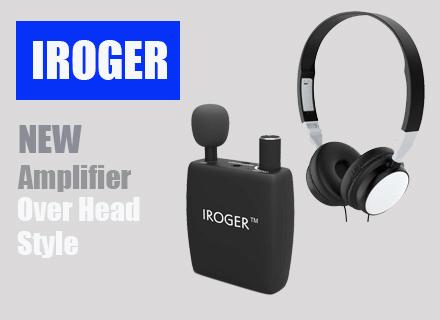Hearing Amplifiers: A Practical and Affordable Solution for Better Hearing

Hearing is something most people don’t think about until it starts to fade. The subtle signs can appear gradually—asking people to repeat themselves more often, turning up the TV volume, or struggling to follow conversations in noisy environments. These small frustrations can grow into major challenges, affecting social interactions, work performance, and overall quality of life.
Traditional hearing aids are often the first solution that comes to mind, but they are expensive, require professional fittings, and involve time-consuming appointments. This is where hearing amplifiers, also called personal sound amplifiers (PSAPs), provide a practical alternative. They are affordable, easy to use, and designed to improve hearing for those with mild to moderate hearing loss.
What Is a Hearing Amplifier?
A hearing amplifier is a small device that picks up sounds from your surroundings, amplifies them, and transmits the enhanced sound directly into your ears. Unlike prescription hearing aids, which are fine-tuned to your specific hearing profile, amplifiers raise the volume of all sounds around you.
From speech and music to environmental sounds like footsteps or birds, these devices make everyday noises easier to detect and understand. You can think of hearing aids as prescription glasses—they are custom-fitted for your needs. In contrast, a personal sound amplifier is like ready-made reading glasses: practical, accessible, and affordable.
Differences Between Hearing Aids and Hearing Amplifiers
It’s common to confuse hearing aids and amplifiers, but they serve different purposes:
-
Hearing Aids
-
Medical devices regulated by health authorities.
-
Require audiologist testing and custom fitting.
-
Designed for moderate to severe hearing loss.
-
Cost ranges from $1,500 to $5,000 per pair.
-
-
Hearing Amplifiers (PSAPs)
-
Consumer devices that don’t require a prescription.
-
Suitable for mild to moderate hearing difficulties.
-
Cost ranges from $30 to $200.
-
Can be used situationally—for watching TV, attending lectures, or social gatherings.
-
For many people, a personal sound amplifier is the first step toward better hearing without the financial and logistical burdens of medical hearing aids.
Why Affordable Hearing Amplifiers Are Popular
The growing demand for affordable hearing amplifiers is due to several practical advantages:
-
Low Cost – They are a fraction of the price of traditional hearing aids.
-
Ease of Access – Available online or in stores without medical appointments.
-
Modern Design – Many models resemble earbuds, making them discreet and stylish.
-
Situational Flexibility – Perfect for lectures, meetings, or watching TV.
-
Boosted Confidence – Clearer hearing reduces frustration and improves social interactions.
These benefits make PSAPs a practical and accessible option for anyone experiencing mild hearing loss or difficulty in specific situations.
Spotlight on iRoger Hearing Amplifier
Among the many amplifiers available today, the iRoger hearing amplifier has become popular for combining affordability with reliable performance.
Features of iRoger:
-
Rechargeable Batteries – No need for constant replacements.
-
Noise Reduction – Separates speech from background noise for clearer conversations.
-
Lightweight and Comfortable – Ergonomic design for long-term use.
-
Simple Controls – User-friendly for seniors or first-time users.
-
Affordable Price – Falls into the category of affordable hearing amplifiers without compromising quality.
While not a replacement for advanced hearing aids, the iRoger amplifier is an excellent solution for people looking to regain clarity in daily life.
Benefits of Using a Personal Sound Amplifier
A personal sound amplifier (PSAP) provides multiple benefits:
-
Improved Communication – Makes conversations clearer, even in noisy environments.
-
Enhanced Entertainment – Enjoy TV shows, music, and movies without struggling to hear.
-
Increased Safety – Hear alarms, traffic, and other environmental sounds more clearly.
-
Reduced Mental Fatigue – Less effort is needed to fill in missing words.
-
Restored Confidence – Easier social interactions reduce stress and embarrassment.
These benefits extend beyond hearing—they improve overall quality of life, independence, and social engagement.
Who Should Consider a Sound Amplifier for Hearing Loss?
A sound amplifier for hearing loss can help:
-
Seniors with mild to moderate hearing difficulties.
-
Adults who struggle to hear in noisy environments, like restaurants or workplaces.
-
Students who need clearer audio in classrooms or lectures.
-
Professionals wanting improved sound clarity during meetings or calls.
-
Hobbyists or outdoor enthusiasts who want to hear subtle environmental sounds.
People with sudden or severe hearing loss should consult an audiologist. For mild cases, a PSAP is a convenient and affordable first step.
Features to Look for in an Affordable Hearing Amplifier
Not all amplifiers are the same. When shopping, consider:
-
Noise Reduction Technology – Helps isolate speech from background noise.
-
Rechargeable Battery – Saves money and hassle over time.
-
Comfortable Fit – Lightweight and ergonomic for daily use.
-
Durability – Can withstand everyday wear and tear.
-
Adjustable Volume – Useful for different situations.
-
Discreet Design – Modern and subtle appearance, often resembling earbuds.
Selecting the right features ensures your amplifier is effective, practical, and long-lasting.
Tips for Using a Hearing Amplifier Effectively
To maximize benefits:
-
Start in Quiet Spaces – Helps your brain adjust to amplified sounds.
-
Adjust Volume Gradually – Avoid high volume to protect your ears.
-
Use Short Sessions at First – Gradually increase duration as you adapt.
-
Clean Regularly – Maintain hygiene and device performance.
-
Be Patient – It may take a week or two to feel fully comfortable.
With consistent use, a PSAP can feel natural and seamlessly improve daily life.
Common Myths About Hearing Amplifiers
Some misconceptions include:
-
“They’re only for the elderly.” People of all ages, including students and professionals, benefit from PSAPs.
-
“They damage your hearing.” Safe use at moderate volumes is not harmful.
-
“They’re bulky or unattractive.” Modern designs are sleek and discreet.
-
“They replace hearing aids.” PSAPs are ideal for mild to moderate hearing loss but are not substitutes for medical-grade devices.
The Future of Personal Sound Amplifiers
Technology is rapidly advancing, making amplifiers more effective and versatile:
-
AI-Powered Sound Processing – Helps distinguish speech from background noise.
-
Bluetooth Connectivity – Allows direct connection to phones, TVs, and other devices.
-
App Integration – Lets users fine-tune sound settings.
-
Ultra-Discreet Designs – Small, almost invisible devices that fit naturally in the ear.
These innovations are bridging the gap between consumer amplifiers and prescription hearing aids, making PSAPs a powerful, accessible solution for everyday hearing challenges.
Conclusion
A hearing amplifier is a practical and affordable solution for people with mild to moderate hearing difficulties. It improves communication, enhances safety, and restores confidence, making daily life more enjoyable.
Whether you choose a general affordable hearing amplifier or a trusted model like the iRoger hearing amplifier, the benefits are the same: clearer conversations, safer surroundings, and renewed enjoyment of life’s sounds.
For those noticing early signs of hearing loss, trying a personal sound amplifier (PSAP) is a low-risk, cost-effective way to reconnect with the sounds that make life meaningful.






